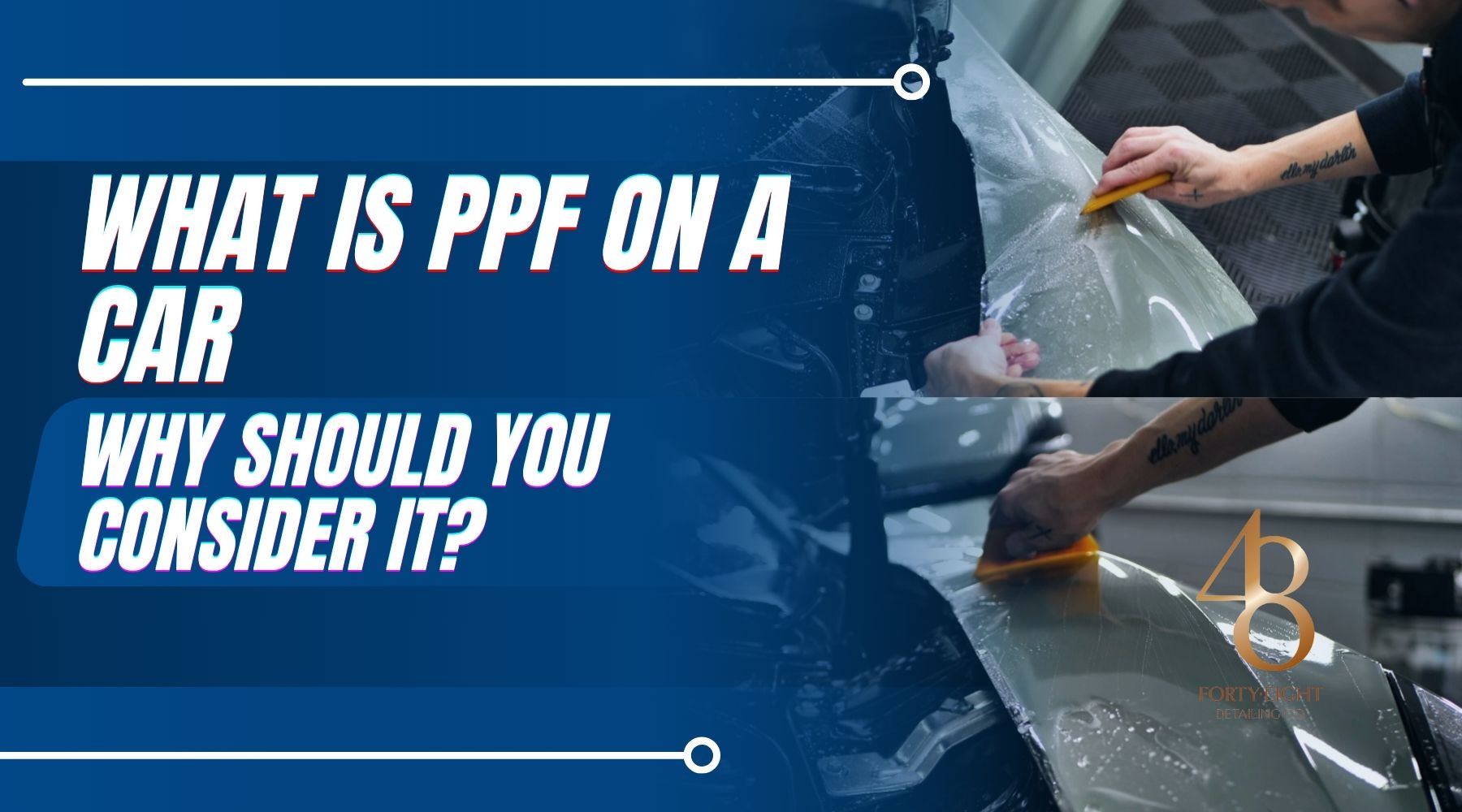Whether you’re driving a high-performance machine or a daily commuter, preserving your car’s pristine appearance in a place like Surprise, Arizona, can be a challenge. Between sun exposure, road debris, and harsh desert elements, your vehicle’s paint is constantly under attack. That’s where Paint Protection Film (PPF) comes in.
So, what is PPF on a car, and why are so many drivers investing in it? This guide breaks it down, from how PPF works to why it’s one of the best decisions you can make for your vehicle’s longevity and value.
What Is PPF on a Car?
Paint Protection Film (PPF), also known as a clear bra for cars, is a transparent, flexible polyurethane film professionally applied to your vehicle’s painted surfaces. This virtually invisible layer serves as a durable barrier that shields your car from:
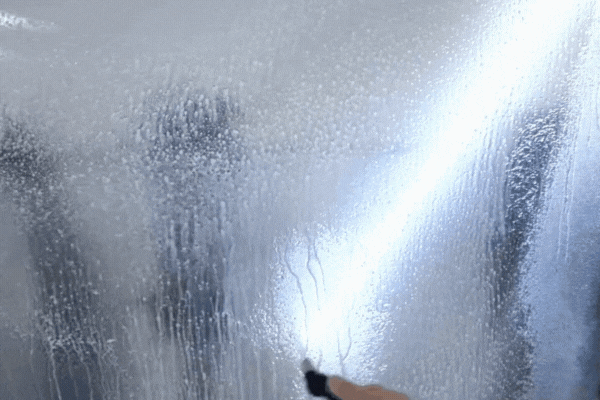
- Rock chips and road debris are kicked up during everyday driving
- Light scratches and swirl marks caused by washing or brushing against objects
- UV rays and environmental contaminants like bird droppings, tree sap, and bug splatter
Modern PPF technology has advanced significantly. Many premium films now come with self-healing properties, allowing minor abrasions to disappear when exposed to heat from the sun or warm water. Some films even offer hydrophobic coatings to repel water, making your car easier to clean and less prone to staining.
When professionally installed, PPF maintains your car’s original look and finish while offering serious long-term protection. It’s an ideal solution for new car owners, luxury vehicle enthusiasts, or anyone wanting to preserve their vehicle’s paint in top condition.
At 48 Detailing, we specialize in high-performance Clear Bra installations tailored to Arizona’s extreme climate, where UV exposure, heat, and dust are constant threats to your vehicle’s finish.
How PPF Works: The Installation Process and Film Types
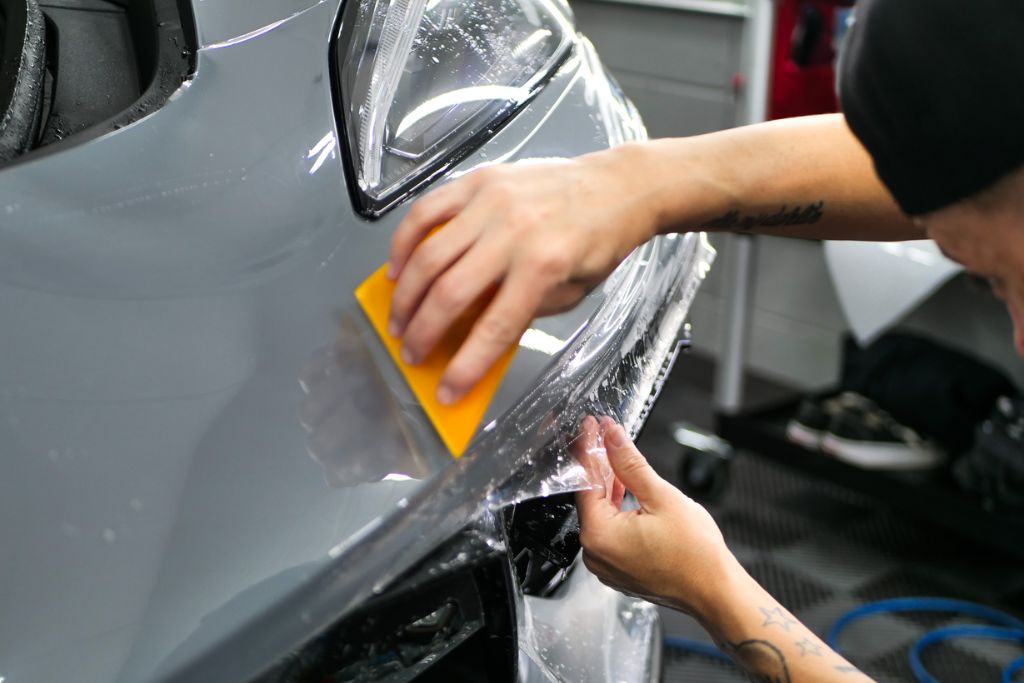
The PPF Installation Process
Installing PPF is a meticulous, multi-step process that requires professional skill and precision. Here’s what it typically involves:
- Surface Preparation: The vehicle is thoroughly washed, decontaminated, and sometimes lightly polished to ensure a clean, smooth base.
- Film Application: Pre-cut or custom-cut film pieces are carefully laid on the vehicle panels using a slip solution.
- Adhesion & Finishing: Installers use squeegees to remove bubbles and ensure the film adheres securely, especially around edges and curves.
- Curing Time: The film sets over the next few days, with full bonding occurring within 48–72 hours.
Types of PPF for Cars
There are several types of PPF to suit different needs and aesthetics:
- Glossy PPF: Enhances shine while providing protection.
- Matte PPF: Offers a satin finish for a unique, stealthy appearance.
- Self-Healing Film: Minor scratches vanish with heat exposure.
- Hydrophobic Coated PPF: Repels water, dirt, and contaminants for easier cleaning.
If you’re unsure which film best suits your vehicle, our experts at 48 Detailing’s PPF service page can guide you.
The Benefits of PPF for Your Car
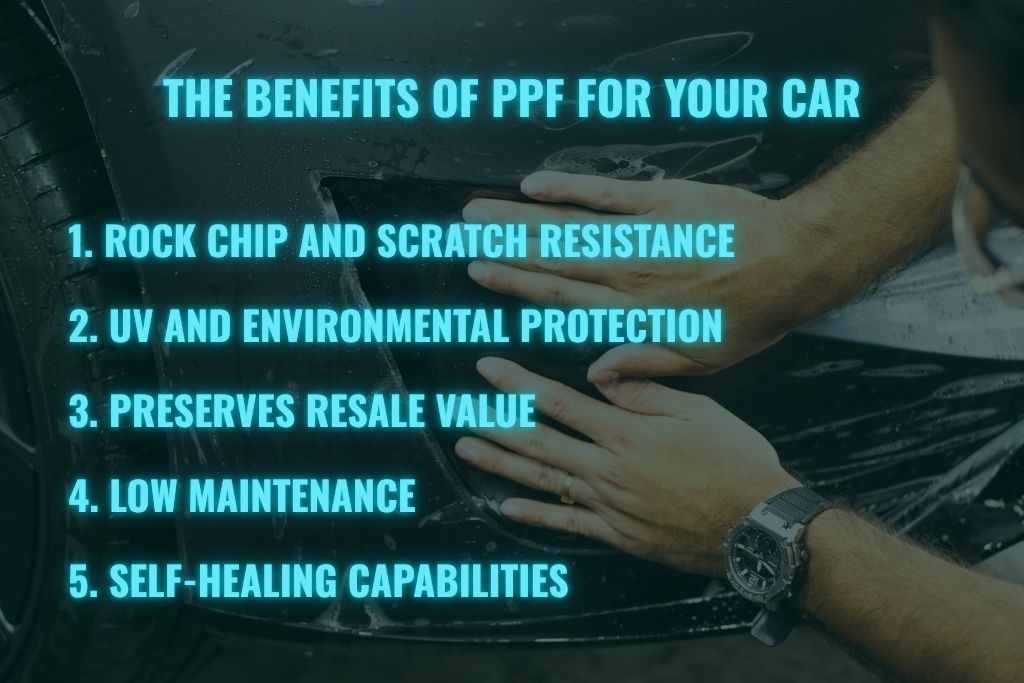
1. Rock Chip and Scratch Resistance
The Arizona highways can kick up plenty of debris. PPF acts as a scratch-resistant film, taking the hit before your paint does.
2. UV and Environmental Protection
UV protection for car paint is crucial in our desert sun. PPF blocks harmful rays, preventing fading, oxidation, and clear coat breakdown.
3. Preserves Resale Value
Buyers often evaluate a car based on appearance. A protected, well-maintained exterior boosts your vehicle’s resale value significantly.
4. Low Maintenance
PPF is easy to clean, stain-resistant, and often features hydrophobic properties that repel dirt and water, reducing the need for frequent detailing.
5. Self-Healing Capabilities
Scratches and swirl marks disappear under heat, maintaining a flawless finish for an extended period.
Discover the real-world benefits of protection in our guide on preventing rock chips with paint protection film.
Addressing Common Concerns About PPF
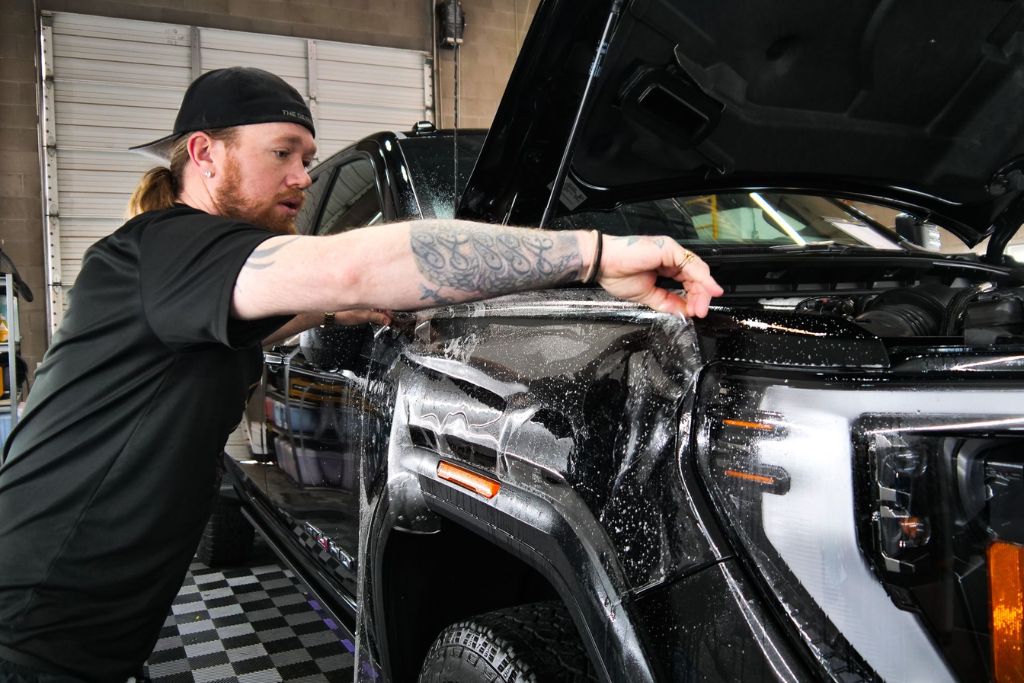
Is PPF Worth It?
Absolutely. While the cost of car PPF can vary depending on vehicle size and coverage area, the long-term savings from avoided paint repairs and retained vehicle value often outweigh the initial investment.
What Are the Disadvantages of PPF on a Car?
Like any product, PPF isn’t perfect:
- Cost: Full vehicle coverage can be expensive.
- Edges: In some cases, edges may be slightly visible.
- Durability: Though robust, it’s not impervious to major impacts or accidents.
- Removal: Removing aged or improperly installed film can be difficult.
Does PPF Damage Paint?
When installed and removed correctly by professionals, PPF does not damage your vehicle’s paint. It protects it. Improper DIY jobs, however, can lead to adhesive residue or clear coat issues.
What Does PPF Look Like After 5 Years?
High-quality PPF, when professionally installed and maintained, remains in excellent condition after five years. However, cheaper films may yellow, peel, or lose clarity over time. At 48 Detailing, we exclusively use premium-grade films designed for long-lasting performance.
Curious about how long your protection will last? Read our post on how long PPF lasts in Surprise, AZ.
PPF vs Ceramic Coating: What's the Difference?
While both Paint Protection Film (PPF) and ceramic coating serve to protect your vehicle’s exterior, they function in very different ways, and often work best when used in conjunction with each other.
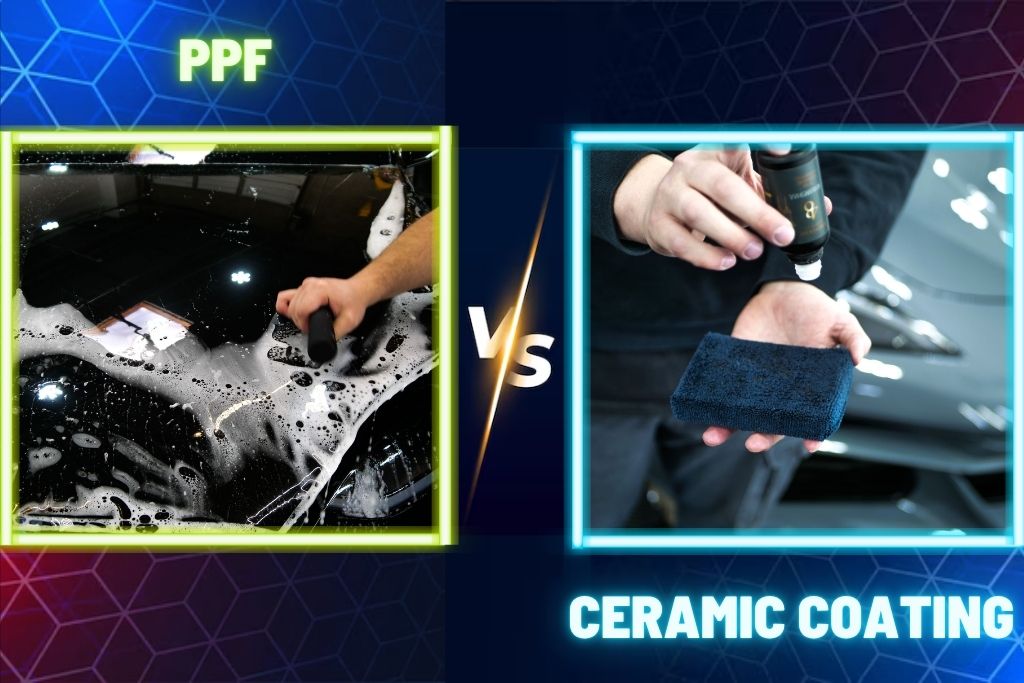
Paint Protection Film
- Acts as a physical barrier against chips, dings, and scratches
- Ideal for high-impact areas like the hood, bumper, and fenders
- Features self-healing technology to repair minor abrasions with heat
Ceramic Coating
- Forms a chemical bond with your paint to enhance gloss and depth
- Creates a hydrophobic surface that repels water, dirt, and road grime
- Great for reducing stains, etching, and maintenance needs
For the ultimate defense and shine, many car owners opt to apply PPF to vulnerable areas and ceramic coating to the entire vehicle for added hydrophobic protection and a stunning finish.
Discover more in our detailed guide: Pros and Cons of Paint Protection Film.
Why Car Owners in Surprise, AZ Trust 48 Detailing for PPF
At 48 Detailing, we’re more than just a detail shop, we’re automotive protection experts trusted by car enthusiasts and everyday drivers throughout Surprise, Arizona. Our mission is to deliver elite-quality results with unmatched care and precision. Here’s what sets us apart:
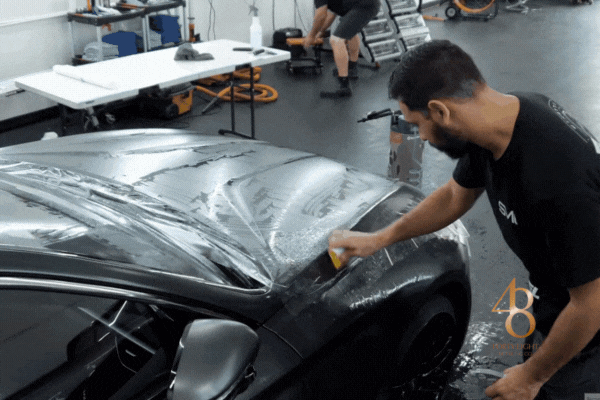
- Premium, self-healing, scratch-resistant films from top manufacturers, ensuring lasting protection and clarity
- Advanced application techniques refined over years of hands-on experience with luxury and high-performance vehicles
- Local climate expertise, we know how Arizona’s intense heat, dust, and UV exposure affect vehicle surfaces, and we tailor our solutions accordingly
- Personalized consultations and transparent service, so you understand every option and get exactly what your vehicle needs.
- Flawless attention to detail, because perfection isn’t optional, it’s expected.
From new car protection to long-term resale value preservation, 48 Detailing is the trusted partner for drivers who want only the best for their vehicles.
🔍 Explore our full list of services on the 48 Detailing homepage.
Final Thoughts: Is PPF Right for You?
In short, what is PPF on a car? It’s your vehicle’s invisible armor, working 24/7 to keep your paint safe from the hazards of everyday driving, especially in the rugged climate of Surprise, AZ.
If you value your car’s appearance and resale potential, PPF is one of the smartest investments you can make. Whether you drive a Tesla, Porsche, or Toyota, our team at 48 Detailing is here to help you protect what matters.
👉 Ready to give your car the protection it deserves? Contact 48 Detailing today for a free consultation or visit our Paint Protection Film service page to learn more.
Frequently Asked Questions (FAQ)
Why should PPF be applied shortly after buying a new car?
To prevent any initial damage and preserve the factory paint in mint condition from the start.
Why do car owners choose PPF over other protection methods?
It offers physical defense against chips and scratches, unlike coatings or waxes, which only provide surface-level chemical resistance.
Why does PPF cost more than wax or ceramic coatings?
PPF involves custom installation, higher material costs, and provides more comprehensive protection.
Why do luxury car owners invest in PPF?
High-end vehicles demand long-term surface protection, and PPF helps retain their value and appearance.

